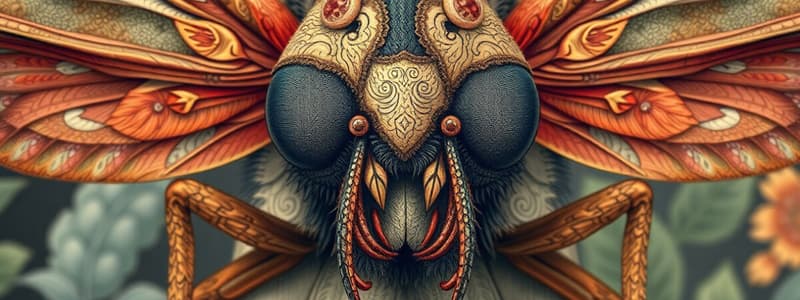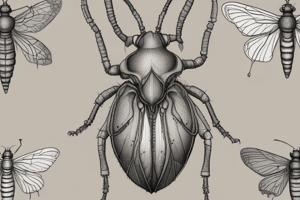Podcast
Questions and Answers
What are the two main categories of insect mouthparts?
What are the two main categories of insect mouthparts?
Chewing (mandibulate) and sucking (haustellate)
What are the five primary parts of the insect mouth?
What are the five primary parts of the insect mouth?
- Upper lip (Labrum) (correct)
- Lower lip (Labium) (correct)
- Clypeus (correct)
- Maxillae (correct)
- Mandibles (correct)
All insect mouthparts are used for chewing.
All insect mouthparts are used for chewing.
False (B)
What is the function of insect antennae?
What is the function of insect antennae?
The insect thorax is divided into three parts: the prothorax, mesothorax, and ______.
The insect thorax is divided into three parts: the prothorax, mesothorax, and ______.
Which structures are called sclerites in the thorax?
Which structures are called sclerites in the thorax?
What is the primary purpose of insect wings?
What is the primary purpose of insect wings?
Match the following mouthpart types with their descriptions:
Match the following mouthpart types with their descriptions:
Which part of the insect's head is considered the anterior area below the dorsum, located between and behind the eyes?
Which part of the insect's head is considered the anterior area below the dorsum, located between and behind the eyes?
In the context of insect mouthparts, which of the following pairs correctly identifies a part of the mandibulate group?
In the context of insect mouthparts, which of the following pairs correctly identifies a part of the mandibulate group?
What specialized structure do haustellate mouthparts possess that is not found in all mouthparts?
What specialized structure do haustellate mouthparts possess that is not found in all mouthparts?
Which of these insects would most likely be categorized under the haustellate mouthparts with stylets?
Which of these insects would most likely be categorized under the haustellate mouthparts with stylets?
Which area of the insect's head is specifically categorized as the liplike sclerite?
Which area of the insect's head is specifically categorized as the liplike sclerite?
What is the primary function of the galea within the insect mouthparts?
What is the primary function of the galea within the insect mouthparts?
Where on the insect head is the gena located?
Where on the insect head is the gena located?
Among the following, which mouthpart type is primarily characterized by modifications of chewing mouthparts?
Among the following, which mouthpart type is primarily characterized by modifications of chewing mouthparts?
What structure is located just dorsal to the subesophageal ganglion in the insect nervous system?
What structure is located just dorsal to the subesophageal ganglion in the insect nervous system?
Which statement differentiates tracheae from Malpighian tubules?
Which statement differentiates tracheae from Malpighian tubules?
How do the reproductive systems of closely related insect species typically differ?
How do the reproductive systems of closely related insect species typically differ?
What allows for gas exchange in insects?
What allows for gas exchange in insects?
Where are Malpighian tubules primarily located within the insect body?
Where are Malpighian tubules primarily located within the insect body?
What characterizes the ventral nerve cord in insects?
What characterizes the ventral nerve cord in insects?
During dissection, which of the following helps to identify tracheae?
During dissection, which of the following helps to identify tracheae?
What is a primary function of the insect's tracheal system?
What is a primary function of the insect's tracheal system?
What distinguishes natatorial adaptations in insects?
What distinguishes natatorial adaptations in insects?
Which structure is primarily modified in females for reproductive purposes?
Which structure is primarily modified in females for reproductive purposes?
In which region of the digestive system does the primary digestion and absorption of nutrients occur?
In which region of the digestive system does the primary digestion and absorption of nutrients occur?
What is the function of the hindgut in the insect digestive system?
What is the function of the hindgut in the insect digestive system?
Which abdominal segments typically house male reproductive structures?
Which abdominal segments typically house male reproductive structures?
What are the dorsal and ventral abdominal segments called?
What are the dorsal and ventral abdominal segments called?
Which of the following groups is known for modifications of the pronotum?
Which of the following groups is known for modifications of the pronotum?
Which structure is characterized by the presence of cerci in adult male insects?
Which structure is characterized by the presence of cerci in adult male insects?
Which statement is true regarding Ivermectin's effectiveness?
Which statement is true regarding Ivermectin's effectiveness?
What is one of the recommended chemical control methods for mosquito larvae?
What is one of the recommended chemical control methods for mosquito larvae?
Which of the following statements is true about dengue?
Which of the following statements is true about dengue?
What characteristic of IGRs (Insect Growth Regulators) allows them to control mosquito populations?
What characteristic of IGRs (Insect Growth Regulators) allows them to control mosquito populations?
What role does environmental manipulation play in mosquito control?
What role does environmental manipulation play in mosquito control?
Which mosquito species is known to transmit yellow fever?
Which mosquito species is known to transmit yellow fever?
What is the primary treatment strategy for Zika virus infection?
What is the primary treatment strategy for Zika virus infection?
Which antimalarial drug is preferred for treating sensitive malaria parasites?
Which antimalarial drug is preferred for treating sensitive malaria parasites?
What is the goal of treating lymphatic filariasis?
What is the goal of treating lymphatic filariasis?
Which condition is characterized by a risk of bleeding if NSAIDs are administered?
Which condition is characterized by a risk of bleeding if NSAIDs are administered?
What type of vector is associated with the transmission of the filarial infection caused by Wuchereria bancrofti?
What type of vector is associated with the transmission of the filarial infection caused by Wuchereria bancrofti?
Which combination of drugs is typically preferred for treating chloroquine-resistant malaria?
Which combination of drugs is typically preferred for treating chloroquine-resistant malaria?
Which of the following statements about the yellow fever virus is correct?
Which of the following statements about the yellow fever virus is correct?
Flashcards are hidden until you start studying
Study Notes
External Morphology
- Head:
- Consists of segments specialized for food gathering, sensory perception, and neural integration.
- Bears eyes (compound eyes and ocelli), antennae, and mouthparts.
- Frons: Anterior part of the head
- Vertex: Area below the dorsum of the head, between and behind the eyes
- Gena: Area below the compound eye, on the side of the head
- Clypeus: Liplike sclerite
Mouthparts
-
The five primary parts of the insect "mouth" are:
- Clypeus
- Labrum (upper lip)
- Mandibles (jaw-like structures)
- Maxillae
- Labium (lower lip )
-
Mandibulate Mouthparts:
- Considered the most primitive type.
- Used for chewing.
-
Haustellate Mouthparts:
- Used for sucking up liquids.
- Divided into two subgroups: those that possess stylets and those that do not.
- Stylets are used to penetrate plant and animal tissue.
- Examples of insects with stylets include Hemiptera, Diptera, and Siphonaptera.
- Nonstylate mouthparts rely on easily accessible food sources like nectar.
- The long siphoning proboscis of butterflies and moths is an example.
Antennae
- Function almost exclusively in sensory perception.
- Detect information such as: motion and orientation, odor, sound, humidity, and chemical cues.
- Basic plan:
- Scape: Segment 1
- Pedicel: Segment 2
- Flagellum: Remaining antennal segments (flagellomeres).
Thorax
-
Divided into three parts:
- Prothorax (first)
- Mesothorax (middle)
- Metathorax (last)
-
Each segment consists of hardened plates called sclerites:
- Nota: Dorsal sclerites
- Pleura: Lateral sclerites
- Sterna: Ventral sclerites
-
Each of the three thoracic segments contains one pair of legs.
-
Wings are found only on the meso- and metathoracic segments.
Wings
- Insects have evolved many variations of the wing.
- Wing venation is a commonly used taxonomic character.
- Membranous wings are thin and transparent.
External Morphology
- Insect head is specialized for feeding, sensing, and neural integration
- Head bears eyes, antennae, and mouthparts
- Mouthparts are either chewing (mandibulate) or sucking (haustellate)
- Mandibulate mouthparts are the most primitive type
- Mandibulate mouthparts consist of clypeus, labrum, mandibles, maxillae, and labium
- Haustellate mouthparts are for sucking liquids and may or may not have stylets
- Insects with stylets include Hemiptera, Diptera, and Siphonaptera
- Insects without stylets rely on accessible food sources like nectar
- Pronotum is the dorsal sclerite of the prothorax and can be highly modified in various insect groups
- Abdomen has dorsal terga and ventral sterna
- Spiracles are found in conjunctive tissue between terga and sterna
- Reproductive structures are located on the 9th segment in males and the 8th and 9th segments in females
Internal Morphology
- Digestive system is a tube-like structure running from mouth to anus
- Digestive system consists of foregut, midgut, and hindgut
- Foregut initiates food breakdown and transport
- Midgut is the primary site of digestion and absorption
- Hindgut reabsorbs water and solutes and excretes waste
- Nervous system includes the ventral nerve cord and the brain (supraesophageal ganglion)
- Respiratory system is made up of tubes (trachea) originating from spiracles
- Trachea deliver oxygen to internal organs and tissues
- Reproductive system varies greatly between species
- Reproductive system consists of male and female genitalia
Medical Importance
- Mosquitoes transmit serious diseases including yellow fever, Zika fever, malaria, filariasis, and dengue
- Yellow fever is caused by a virus in the flavivirus genus
- Zika virus infection does not have a specific treatment
- Malaria is a life-threatening parasitic infection
- Filariasis is a nematodal infection caused by Wuchereria bancrofti
- Dengue fever is caused by a virus in the Flaviviridae family
Mosquito Control
- Genetic control aims to drive transgenic mosquitoes incapable of transmitting parasites through wild populations
- Physical control involves source reduction and drainage
- Environmental manipulation alters breeding places to make them unsuitable for larvae
- Chemical control includes oils, larvicides, insecticides (DDT), and insect growth regulators (IGRs)
- Integrated control combines biological and insecticidal methods
Studying That Suits You
Use AI to generate personalized quizzes and flashcards to suit your learning preferences.




